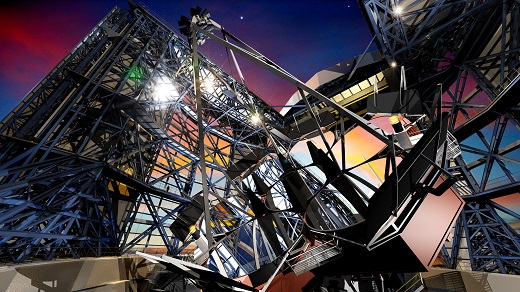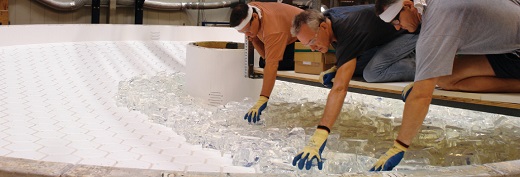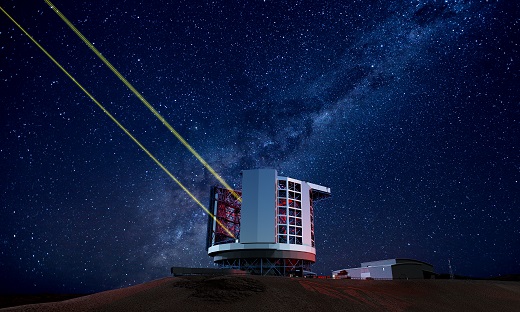Casting has begun for the fifth mirror of the Giant Magellan Telescope (GMT), a 24.5-metre near infrared and visible telescope comprising seven 8.4-metre mirror segments with a total collecting area of 368 square metres.
The GMT will be located in the Chilean Andes and have a resolving power 10 times that of the Hubble Space Telescope. It will have costed approximately $1 billion by the time of its planned first light in 2022, where it will be used to study exoplanets and to look back to the early formation of galaxies.

The GMT near infrared/optical telescope will comprise seven 8.4-metre mirrors to form a 368 square metre collecting area with resolving power 10 times that of the Hubble Space Telescope. (Image: Mason Media)
The GMT joins two other ‘extremely large’ telescopes current under construction: the European Extremely Large Telescope and the Thirty Meter Telescope, each also costing over $1 billion, with plans to build them in Chile (southern hemisphere) and Hawaii (northern hemisphere) respectively.
The fifth mirror is being cast at the University of Arizona’s Richard F Caris Mirror Laboratory, where 20 tonnes of glass will be melted in a spinning furnace. Once cooled, the glass disk will be polished to its final shape using state-of-the-art technology developed at the university.
'The Giant Magellan Telescope project will enable breakthrough discoveries in astronomy, and perhaps entirely new fields of study,' commented Dr Robert Shelton, president of the Giant Magellan Telescope Organization (GMTO).
Each of the GMT’s mirrors begins as precisely 17,481kg of custom-made pristine blocks of low-expansion E6 glass from the Ohara Corporation in Japan, which are hand-placed one-by-one into a custom-built furnace pre-loaded with a hexagonal mould. At the peak of the lengthy casting process, in which the giant furnace spins at up to five revolutions per minute, the glass is heated to 1165°C for about four hours until it liquefies and flows into the mould.

The casting process involves placing 17,481kg of custom-made pristine blocks of low-expansion E6 glass by hand into a hexagonal mould. (Image: GMTO)
The casting process continues as the glass is carefully cooled for three months while the furnace spins at a slower rate. The glass then undergoes an extended period of high-precision shaping and polishing, until it is polished to an accuracy of one twentieth of the wavelength of light, or less than one thousandth of the width of a human hair.
With the latest casting, the fifth mirror joins three other GMT mirrors currently at different stages of production in the Mirror Laboratory. Polishing of the second mirror’s front surface is well underway, coarse grinding will begin on the front of the third mirror shortly, and the fourth, central mirror will soon be ready for coarse grinding after the third.
The first GMT mirror was completed several years ago and is currently in storage, awaiting transportation to Chile. The glass for the sixth mirror has already been delivered, and the seventh mirror’s glass is on order from the Ohara factory in Japan.
Once completed, the giant mirrors will be transported to future GMT site at the Las Campanas Observatory in the Chilean Andes, where ground has already been broken. The site is known for being one of the best astronomical sites on the planet with its clear, dark skies and stable airflow producing exceptionally sharp images.

The Las Campanas Observatory in the Chilean Andes provides the clear, dark skies and stable airflow needed to produce exceptionally sharp images. (Image: Mason Media)
‘Creating the largest telescope in history is a monumental endeavor, and the GMT will be among the largest privately-funded scientific initiatives to date,’ said Taft Armandroff, vice-chair of the GMTO board of directors and a professor of astronomy at The University of Texas at Austin. ‘With this next milestone, and with the leadership, technical, financial and scientific prowess of the members of the GMTO partnership, we continue on the path to the completion of this great observatory.’
Related News
Glyndwr scientists exceed polishing specifications for E-ELT telescope mirror
ESO awards major component contracts for European Extremely Large Telescope
ESO signs contracts for Extremely Large Telescope’s 39-metre primary mirror

